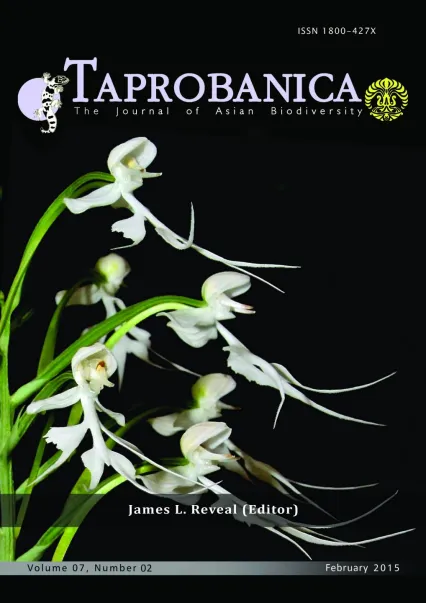

v7i2.170
Special Issue (Plants ) | Volume 7 | Number 2 | 2015
Short Note
ISSN: 1800-427X (print)
eISSN: 1800-427X (online)
DOI:10.47605/tapro.v7i2.170
Submitted date: 19 May 2014
Accepted date: 6 August 2014
Published date: 20 February 2015
Pp. 91–93.
Rediscovery of two Pyxine (Physciaceae) species from the Western Ghats
H. Biju*, R.G. Bagool & S. Nayaka
*Corresponding author. E-mail: drbijutbgri@gmail.com
The lichen genus Pyxine was established by Elias Fries in 1825 and it is a prominent member of the family Physciaceae. The genus Pyxine is mainly pantropical to subtropical with several species extending into temperate or oceanic regions, and comprises ca. 65 species. Index Fungorum (www.indexfungorum.org) holds a total of 162 records for Pyxine, which include 96 species and several infra-specific taxa. However, many taxa in that list need validation (e.g., P. consocians Vain. is mentioned as synonym of P. subcinerea Stirt.). In India, the genus harbors about 26 species, of which 10 are recorded for Kerala. Pyxine is characterized by dorsiventral, appressed, foliose thalli with linear radiating lobes, anatomically heteromerous, paraplectenchymatous upper cortex, white or yellow medulla, fibrous lower cortex, laminal apothecia with thalline or pseudothalline margin, epithecium K+ violet-purple, dark brown hypothecium, generally two-celled, mischoblastiomorphic brown spores, and simple paraphyses.
Section Editor: William R. Buck
eISSN: 1800-427X (online)
DOI:10.47605/tapro.v7i2.170
Submitted date: 19 May 2014
Accepted date: 6 August 2014
Published date: 20 February 2015
Pp. 91–93.
Rediscovery of two Pyxine (Physciaceae) species from the Western Ghats
H. Biju*, R.G. Bagool & S. Nayaka
*Corresponding author. E-mail: drbijutbgri@gmail.com
The lichen genus Pyxine was established by Elias Fries in 1825 and it is a prominent member of the family Physciaceae. The genus Pyxine is mainly pantropical to subtropical with several species extending into temperate or oceanic regions, and comprises ca. 65 species. Index Fungorum (www.indexfungorum.org) holds a total of 162 records for Pyxine, which include 96 species and several infra-specific taxa. However, many taxa in that list need validation (e.g., P. consocians Vain. is mentioned as synonym of P. subcinerea Stirt.). In India, the genus harbors about 26 species, of which 10 are recorded for Kerala. Pyxine is characterized by dorsiventral, appressed, foliose thalli with linear radiating lobes, anatomically heteromerous, paraplectenchymatous upper cortex, white or yellow medulla, fibrous lower cortex, laminal apothecia with thalline or pseudothalline margin, epithecium K+ violet-purple, dark brown hypothecium, generally two-celled, mischoblastiomorphic brown spores, and simple paraphyses.
Section Editor: William R. Buck
- List of Articles & Contents





